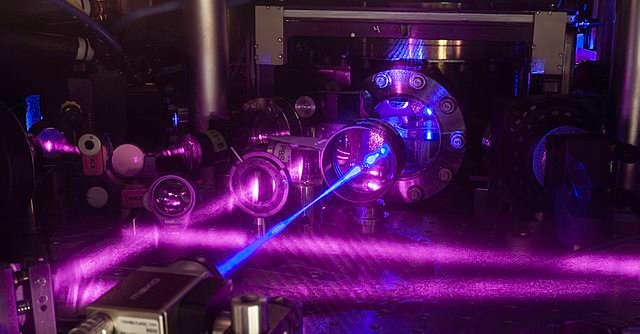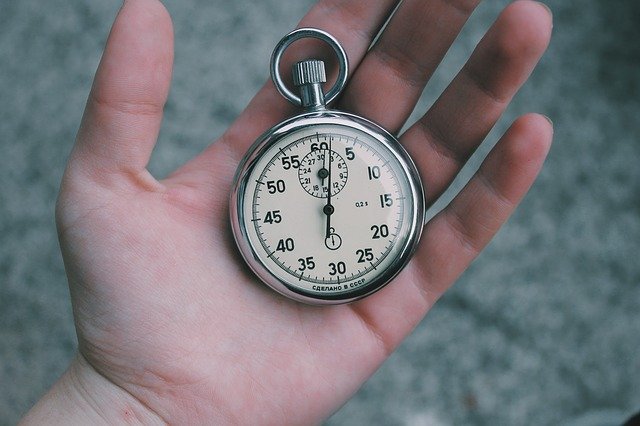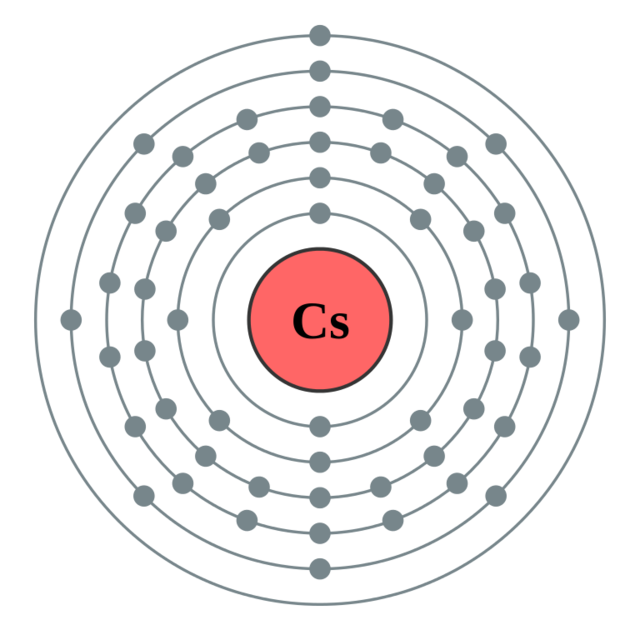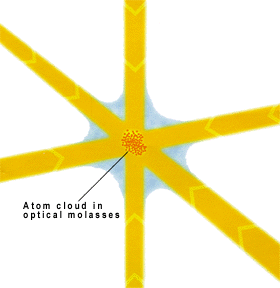Defining time with atomic fountains
For ages, physicists have been trying to define time as precisely as possible. Today, the progress is such that one can define a second with a level of precision reaching 16 digits.

[image credits: Francis Flinch (public domain)]
This post is about time, and in particular about how physicists define time. @lamouthe (in her post here), @greenvago (in her post here; happy birthday, by the way ^^) and @rudyardcatling (in his comment to my posts) can now be happy ;)
Time is established from the International Atomic Time, which serves as a basis to setup the UTC time, i.e. the Coordinated Universal Time.
The latter is what regulates all clocks around our planet. It is thus damned important.
The TAI (and thus the UTC) is fixed according to atomic clocks, that are devices using some atomic properties to establish what is a second. Since the 1980s, a specific class of atomic clocks named atomic fountains are used and have allowed us to define a second at the 16-digit level.
This is the topic of this post, where I discuss how time is defined metrologically. And as a bonus, some atomic physics for free is available ;)
A SECOND IN THE EARLY DAYS (BEFORE THE 1960S)
But let us start with the beginning and focus on the second itself. A second is the unit of time included in the International System of units, abbreviated as SI (once again from the French version won).

[image credits: Pixabay (CC0)]
But this does not tell us what a second is. For that, please hold on for a second. I know: I ate a clown today and here is the proof.
In the ancient times, a second was defined relatively to the way our planet rotates. History indeed tells us that a second was defined as 1/86400 day before the 1960s.
This number is easy to get: we have 24 hours in a day, 60 seconds in an hour and 60 minutes in a second. The rest is a matter of multiplying numbers all together.
However, this is by far not precise! Earth rotation, which defines a day, is irregular. It show fluctuations here and there, and those fluctuations are bad for a standard. We need something better, more precise and especially more stable and uniform.
This is where the ephemeris time came into the game in the 1940s-1950s. Earth rotation around the sun is stabler that Earth rotation on itself, and metrologists from that time decided to move on with another definition of time.
The second hence became 1/31556925.9747 of the tropical year for 1900, this year being taken starting at January 0 at noon. And believe it or not, this is not the usual stupidity I am hiding in my posts. This is a real thing.
While this is used as a reference, something more practical appeared in the 1950s-1960s: atomic clocks. These devices were amazingly convenient as super stable and uniform. Natural players to become a new standard.
ATOMIC PHYSICS IN NUTSHELL
Before discussing atomic clocks (this will come in due time… the clown is back), let us focus for a second (again) on atoms, and in particular on how atoms are made.
Atoms are made of a core, the atomic nucleus determining the atomic species, and a bunch of electrons orbiting around it. An illustration is shown below with a cesium atom.

[image credits: DePiep (CC-SA 2.0)]
We have here a core made of 55 protons and neutrons, and 55 electrons around it.
The electrons cannot however be randomly distributed around the nucleus, and they fill what are called electron shells.
On the picture, each line around the nucleus is a shell, and it can receive a well-defined maximum number of electrons.
The fundamental level of the atom, for which the energy is minimum, is the one in which we start filling the shell that is the closest to the nucleus, then moves with the next-to-closest, and so on until we have added all the 55 electrons.
In order to take one of the electrons and move it away, in a more outer shell, one needs to provide the atom some energy, bringing it in a so-called excited state. Inversely, an excited atom will naturally move back to its fundamental state by emitting some energy.
Quantum mechanics however tells us exactly how much energy is involved in a specific transition, and that this value is unique.
ATOMIC CLOCKS
Atomic clocks use this principle in a very simple manner.

[image credits: Zubro (CC-SA 3.0)]
One starts with a bunch of atoms prepared in a state of given energy E, and we bombard them with some microwave photons in order to bring them in a targeted excited state of energy E’.
As we know both energies E and E’, we also know the energy needed by the photons.
I recall that for photons, energy and frequency are proportional to each other, as detailed here.
We thus only need to generate photons at the right frequency to allow for the E to E’ transition at a huge rate.
By counting the number of atoms of energy E’ that we get, one can tune the photon energy (or frequency): The closest the photon energy will be from the E-E’ difference, the largest amount of atoms of energy E’ we will get. Easy!
In other words, we have an oscillator, and the idea is to tune its frequency to the frequency of the atomic transitions. By connecting an electronic circuit to the oscillator, we obtain a clock.
Using cesium atoms, the right frequency is 9192631770 Hz. And since a second is the inverse of a Hertz, here is our definition, which lasts since 1967.
ATOMIC FOUNTAINS
In the 1980s, a new type of atomic clocks was designed: the so-called atomic fountains.
One of the major issue with the performances of the atomic clocks is connected to the speed of the atoms. If they are cold, they move slowly and physicists have time (yeah… again) to compare the frequency of the oscillator with the one of the atom.

[image credits: Andreas Lilius (CC BY-SA 3.0)]
In order to slow down the cesium atoms and cool them down, the idea is to bombard them with a bunch of lasers with the right frequencies, as depicted in the picture on the left.
The area where the lasers cross consists a kind of viscous medium where the atoms are kind of glued. They are slowed down very efficiently.
In other words, they are cooled down to temperatures very close to the absolute zero. In fact, just a billionth of degree above it.
After being cooled down, the atom are thrown upward, at an altitude of about a meter, and they then fall by gravity. The setup is called an atomic fountain. I think the name speaks for itself. We should just imagine many many atoms.
Metrologists then probe the properties of the atoms during its rise and its fall.
They have managed in this way to improve the precision of the clocks by a factor of about 100. In other words, a leap second has to be inserted once every 300 million years!
This is precision, isn’t it!
SUMMARY
In this post, I browsed how time was defined by physicists. Starting with the early days using the motion of Earth, I moved on with the atomic clocks and fountains using the cesium energy levels to define a second.
The idea behind that is to bombard cesium atoms with photons of a given energy and to tune the frequency of the photons so that a maximum of atoms will undergo a specific electromagnetic transition. The tuned frequency is then the one used for defining a second, as we theoretically know what it is.
Thus being said, better clocks exist today, using different atoms. Targeting transition with much larger frequencies, one can then easily reach precision and stability of 16 to 18 digits. For instance, strontrium or mercury, etc.
A stupid stuff is hidden in this post… Can you find it? And it is better hidden than usual ;)
STEEMSTEM
SteemSTEM is a community-driven project that now runs on Steem for more than 1.5 year. We seek to build a community of science lovers and to make the Steem blockchain a better place for Science Technology Engineering and Mathematics (STEM).
More information can be found on the @steemstem blog, on our discord server and in our last project report. Please also have a look on this post for what concerns the building of our community.
Disappointing title this time. No innuendos. 😔
As a philosopher, I was hoping for a philosophically deeper definition of time. The concept of time is controversial in my discipline (and sometimes even in yours). I tend to think that it doesn't really exist. At least not in the way we think it does. But I've far from made up my mind yet. It's quite a tricky topic.
If less leaps means better clock, what about a tick-tock that makes people leap in clubs all the time?
Sorry, my jokes are bad today. (
This is why you should write about it. I am only here for the physics part :)
Well. time is uniquely defined. Or at least the second is. But as soon as one starts to live in the world of the elementary particles, time is not special anymore and behave as any other spatial dimension. So here, I would not say anything is controversial bu instead well defined.
Argh... :D
ah, i suffer from the same problem. I see time as something defined by men (or women, let's say sapients) in order to be able to measure and describe the changes in systems but it actually has or is no force of it's own, just like numbers are needed in order to measure, but they don't exist in the physical universe. I've been yanking the man's chain about it several times lol, and here's the article. A bit more like that and i'm gonna blush .. :))
Well, in terms of physics time is very well defined. And I have tried to explain how. The rest is philosophy ;)
Lol...
I'd love to read about your views on time someday sir.
Some day some day maybe ;)
Hello dear friend, your post is very awesome, I recently joined to steem and met your blog, I really like your posts cause i like physics, cosmology,... as like you. I upvoted and follow you, please see my blog to support each other. thanks for sharing useful and beautiful posts. have good time.
Source
Leaving comments asking for votes, follows, or other self promotional messages could be seen as spam.
More Information:
The Art of Commenting
Comment Classifications
Thanks for passing by.
I noted that you have sent a similar message to many many steemians. This is not the best way to get followers and upvotes; it could even got you some flags (not by me today but I know some people who could).
IMO, the best way is to engage people sharing similar interests to yours, without begging for upvotes/followe, and the rest will come by itself.
Now of course, you can do what you want. This was just my two cents ;)
woaw, a brief history of time according to @lemouth AND an honourable mention omg i'm not worthy.
so i guess i can rest easy in my lifetime on the part of measurement however (here i go again) from my obnoxious point of view this is still time as on observation through the change in systems (over time ... its paradoxical like that somewhat) where time is not an actual existing force that pushes or pulls or physically alters anything at all. It is defined (with great precision as i now understand) in order to be able to describe the changes in these systems. Where for instance i read about how a clock will behave differently the further away it gets from the core of the planet (the gravitational pull so to speak) and people write about that as if time itself slows down but, and as you describe here is that not simply the mechanics altering at atomic or sub-atomic level due to the change in gravitational pull ? it's fascinatings matter, well time actually i'll never get enough of this, thank you so much for taking the time (eh, it seems to be unavoidable, i see) to write this, but i think i will read the part on atomic physics 2 or 3 times more nowi see i'm not the only one with philosophical issues on the matter either here, but it's great to have debate isn't it
( im sure you must have read about it btw :: https://steemit.com/rudyardcatling/@rudyardcatling/link-to-bbc-stephen-hawking-ballot-opens-for-westminster-abbey-service , to be enterred between newton and darwin, that should make for great conversations during the witching hours there , shame i can't go )
thanks again for taking the time to explain it from your point of view in understandable language!!!!!
tsk, i wanted to give a 100% vote actually but i suppose that doesn't really matter much, fabulous work as always !
Thanks for the nice comment!
No it is not. Time is defined from something and that's it.
To answer the rest of the comment, time is a relative quantity and not an absolute one. For instance, as soon as gravitational effects matter, one needs to account for general relativity corrections. For the same reason we need to measure time very precisely in fact: this will allow us to test general relativity to a very high level of precision. See here for an experiment connected to this :).
I have a question related to time. If our universe was a box with a lot of particles (in thermal equilibrium), does that imply it is meaningless to have a concept of time in this system? So in other words, is time a concept tied to the nature of the system?
Except at the big bang itself, time (actually spacetime) is always well defined. If we take a system that is a box (even if it does not match our universe), why could not time be defined in there?
OK. I have heard about ENTROPY AS AN ARROW OF TIME. In the particles box (equilibrium state), isn't the entropy kinda saturated?
Entropy increases or stay constant with time, this is true. But this does not influence how time passes by.
January 0 ?
The idea of cooling with lasers is a bit like counter-intuitive.. but so ... mmm cool ! ;)
January 0, yes. They didn't want to refer to the 31st December of the previous year, so that metrologists f this time introduced this January 0 day.
This relies on the radiative pressure of the electromagnetic field associated with the laser that can slow down (and thus cool down) the atom.
Would there be any practical benefit to a future technology able to define the second to even greater than 16-18 digits? It seems like atomic fountains have pretty muched reaches the limit of practical effects - but then again I never cesse to be surprised by the usefulness of extreme accuracy
GPS? They are already synchronised on atomic fountains. On the other hand, this is very useful to test general relativity at its most fundamental level, but this is far from being practical of course.
Hey @lemouth, thanks for another interesting read!
Lol!
I was wondering why they do this but then you got me!
Just wow!
By the way, apart from experiments conducted by physicists, are there any other applications that would demand precision of measured time of up to 16 to 18 digits? 10^(-18) sec is one insanely small time interval! Just wondering!
Have a good day!
GPS synchronization relies on atomic fountains. Except this, we need such a precision to test general relativity to its deepest details (some reference to @alexander.alexis). See fo instance the Pharao project.
Cool post, now I have an idea how a atomic clock works.
One question: What do you mean by saying that the rotation of the earth isn't stable. Is the speed really not constant? Even unpredictably inconstant?
Earth slows done. Days are getting longer by 1-2 milliseconds every thousands of years. Moreover, Earth rotation also depends on the position of Earth relatively to the sun. Those are small effects, but important for precision.
Exactly the question I wanted to ask. Because the reason why we are not feeling the impact of the rotation of the earth is because it is doing so at a constant velocity. So, the velocity is not so constant afterall, just that its variableness is very small. But what happens when the earth stops rotating or when its rotating speed is no longer constant?
The rotation speed is not constant, but the non-uniformity are so small so that it won't change anything for us.
Earth may also stop rotating at some point, but this is not even clear. I mean, there are so many effects involved there (tides) and they may change over time. I really think we are fight for the next hundreds of billions of years. Note that I have no source on this under the hand... The calculations should however exist somewhere (no time to google that for now, sorry).
No problems... thank you sir for the time taken to explain this
You are very welcome!
A not so scientific subject which I find fascinating is our own perception of time.
I could swear that seconds were elapsing much slower when I was a kid. 😀
But of course that's a hard one to prove...
I remember a program on TV about this subject.
People where put in successive rooms lit with a different colour and asked to press a button when they thought a minute had elapsed.
The results where widely different from room to room but what is interesting is that most people would underestimate or overestimate the time based on the colour. the direction of the error was consistent across the volunteers which indicates that some external factors affect consistently our perception of time
I think that this is the case for many many people. However, you rather need a neuropsychologist here instead of a physicist.
This is a funny correlation! Having the opinion of a neuropsychologist may be interested to head. Tagging @abigail-dantes just in case she would have some information here,
I "heard" my name and here I am with a cup of tea :P
Hey @irelandscape, nice to meet you! Your comment is very interesting indeed. I read about such experiments before. However, all I know about the influence different colours have on the distorted perception of time is that it results from the kind of emotions (extent of arousal) the given colour prompts. It all begins with the activation of photo-receptors (cones and rods), but this is just as far as I remember! From here, I would have to brush things up to provide more info :P
You guys have a nice day! :*
Hi, yes your explanation rings a bell.
I think I saw this in a BBC program. Might have been horizon but I'm not sure.
I always thought our perception of time should be on the same footing as our 5 other senses.
I'm not sure how understood our internal clock is.
When I wake up in the middle of the night I like guessing what the the time is.
Surprisingly my guess is usually not too far off, often within 20 minutes accuracy.
Weird.
This kind of raises the question as to how the energy of the photon is measured to the precision required to convert it into the desired unit of time.
It feels like the chicken and the egg problem...
The energy of the photon is measured through the frequency of the laser that is adjusted as finely as possible. For photons, energies and frequencies are the same thing, give or take. The precision of the laser of course limits the precision of the full thing.
There's something I'd like to understand. Is UTC the same as GMT? While growing up, I heard majorly about GMT, but it seems UTC has overridden that.
An unrelated question: I read an article that stated that the earth's day is getting longer by few miliseconds every 100years. Does this have effect on the Gravitational time dilation?
PS:
Huh? You ate a clown? :D
There is a slight difference, at the conceptual level: UTC is a time standard and GMT is a time zone. But the time itself is the same.
Every thousands of years actually. In principle, there is an impact, but you need to integrated over billions of years to notice it.
Thanks a lot for the quick lectures.
Always a pleasure my friend :)